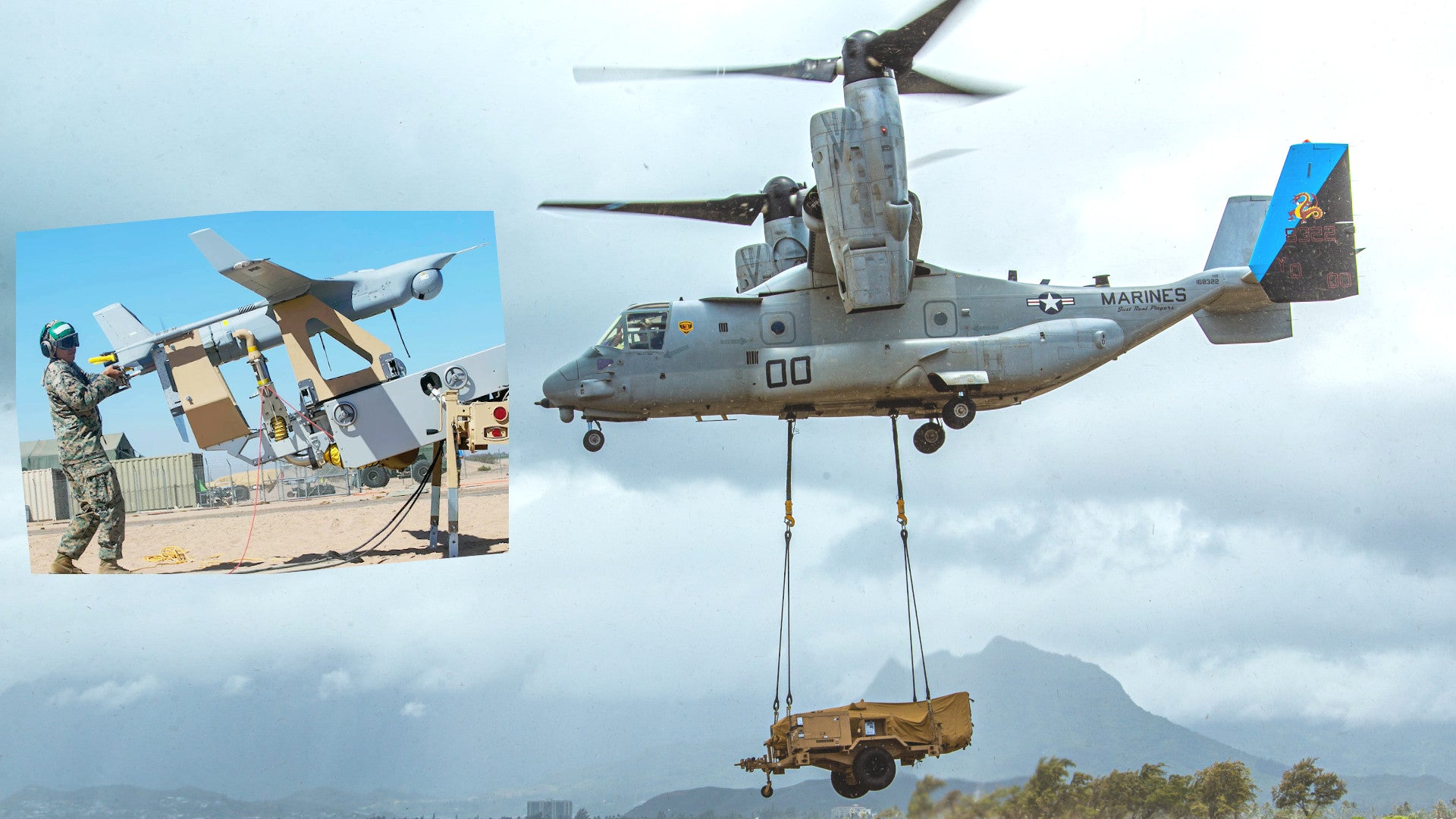In a first for the service, U.S. Marines from Combat Logistics Battalion 3 slung components of an RQ-21 Blackjack unmanned aerial vehicle system under MV-22 Osprey tiltrotors and airlifted them to a forward site as part of an aerial insertion exercise.
The maneuvers staged out of Marine Corps Base Hawaii on Aug. 5, 2020, involved an RQ-21 system and crew from Marine Unmanned Aerial Vehicle Squadron 3 (VMU-3), the “Phantoms,” and Ospreys belonging to Marine Medium Tiltrotor Squadron 268 (VMM-268), the “Red Dragons.” Both units are stationed at Marine Corps Base Hawaii, Kaneohe.
The sortie, in which the Blackjack system was airlifted from Kaneohe to nearby Marine Corps Training Area Bellows, was part of a wider demonstration of the composite assault support capabilities of the island’s resident Marine Aircraft Group 24 (MAG-24). RQ-21s are also an important part of the Aviation Combat Element of Marine Expeditionary Units (MEU), with a typical one of those task forces having five of these drones as its only organic unmanned assets.


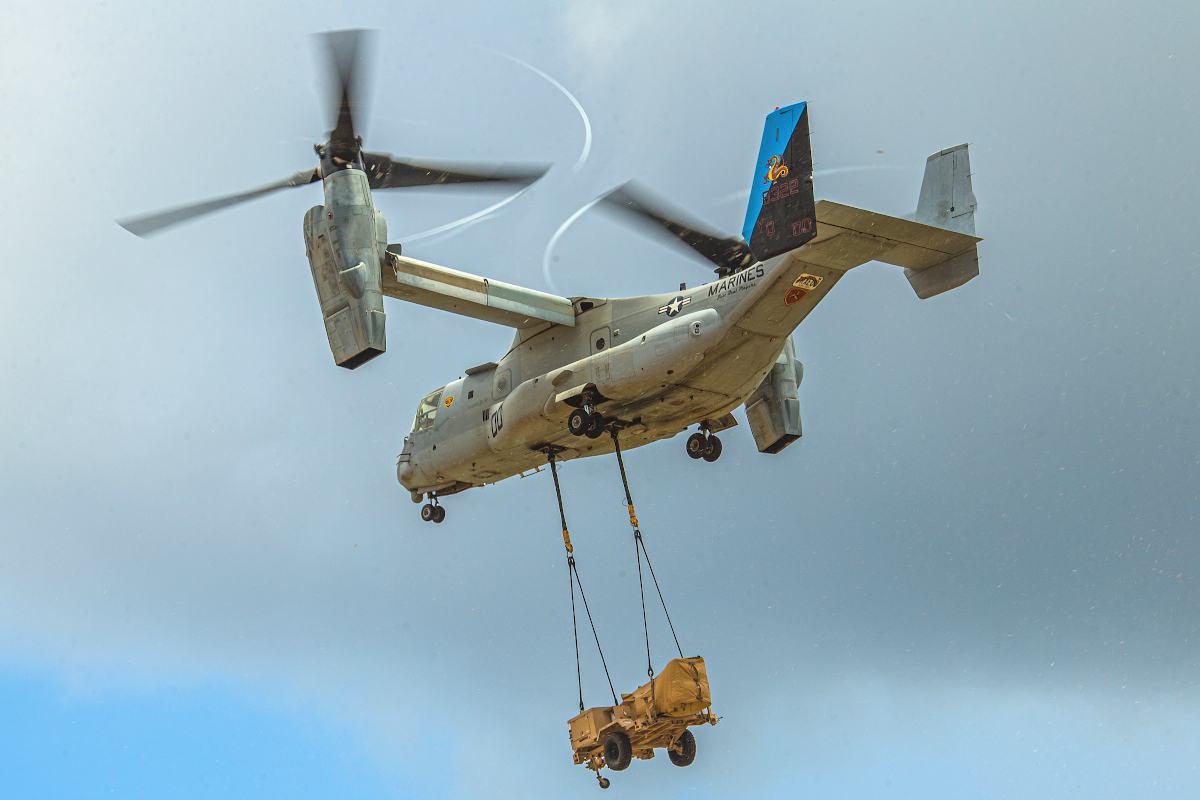
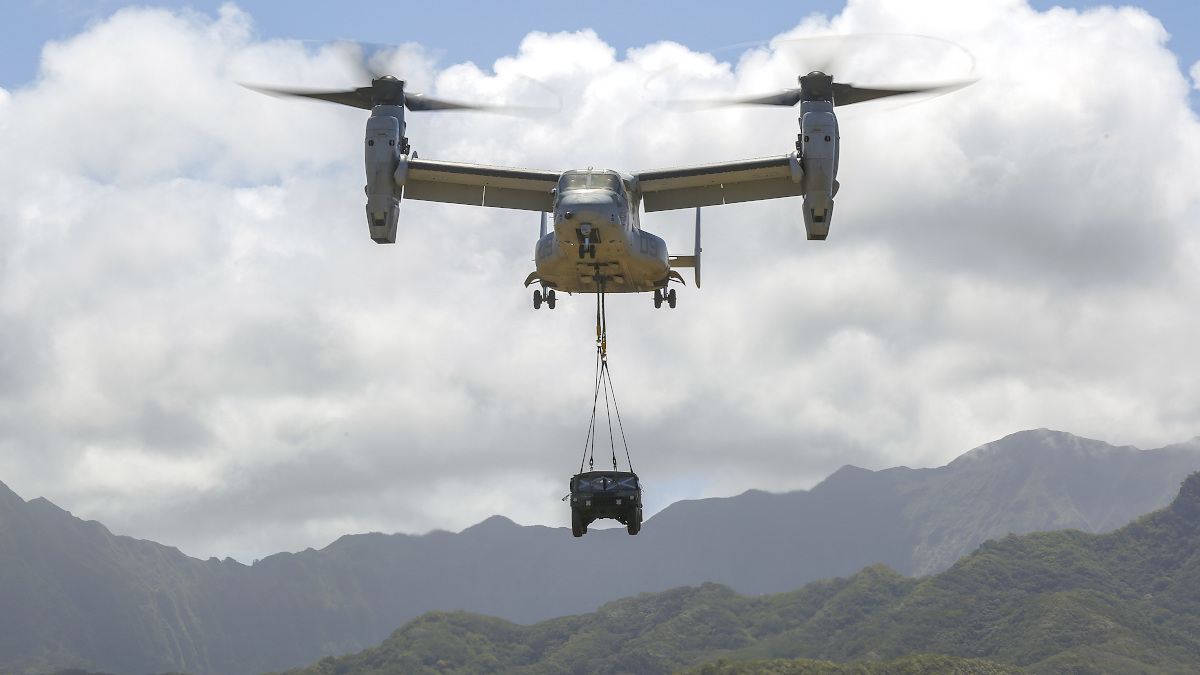
The Hawaiian exercise demonstrated how the Ospreys might provide ship-to-shore transport for the RQ-21 system to rapidly establish a vital overwatch capability or to perform other intelligence, surveillance, and reconnaissance missions during an expeditionary campaign. Land-based task forces could also use this technique to quickly move the drones into position at forward sites for the same purposes.
The Blackjack, which entered Marine Corps service in 2014 as a replacement for the RQ-7B Shadow, offers a 16-hour endurance and, importantly, can operate from virtually any suitably flat surface, including the decks of amphibious assault ships, via a pneumatic catapult launcher and a Skyhook recovery system. A typical complete system comprises five individual RQ-21 drones, the catapult, the Skyhook, two trailer-mounted generators, and four Humvees carrying other components. All of this is relatively mobile, as the Hawaiian exercise showed.
The video below shows the launch and recovery processes for the RQ-21.

The RQ-21’s line-of-sight control system restricts its range to around 50 miles, although this can be extended using “hub-and-spoke” tactics with other drones acting as signal relays back to the ground control center. The Blackjack’s basic sensor suite includes electro-optical cameras for daylight full-motion color video and infrared ones for nighttime work, plus a laser rangefinder and an infrared pointer. Currently, it doesn’t carry a laser designator, but this is planned as a future upgrade.
The drone’s payload bay can accommodate other appropriately sized systems up to a weight of 25 pounds, according to the Marines. The Corps has already taken advantage of this, introducing the AN/PDY-2 Split Aces synthetic aperture radar, which has a ground moving target indicator capability, and the AN/DSY-4 Spectral Bat signals intelligence (SIGINT) suite as payload options in recent years. You can read more about those systems in this previous War Zone
Marine Blackjacks are also set to soon receive Logos Technologies’ Cardcounter wide-area persistent-surveillance system, too. In July 2020 the company was awarded a $6.7-million contract to develop and flight-test the Cardcounter, which is derived from the same firm’s BlackKite sensor. Logos had previously tested its earlier RedKite system on the RQ-21, as well.
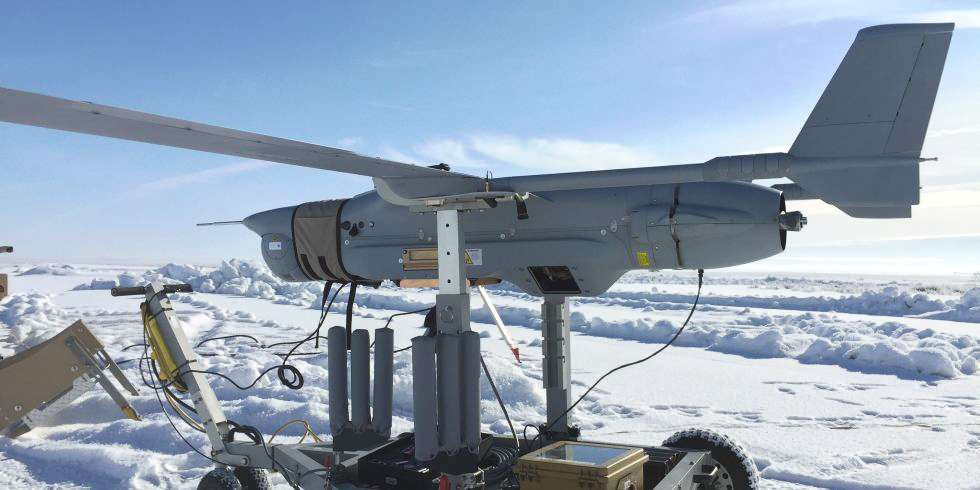
“In embracing miniaturized wide-area motion imagery systems for tactical UAS, the Department of Defense is taking a technology that has already proven itself on the battlefield with aerostats and providing the tactical commander with guardian angel-like overwatch,” Doug Rombough, Vice President for Business Development at Logos Technologies, said in a press release. Cardcounter, which weighs less than 28 pounds, will be able to image an area of more than 5 square miles, allowing sensor operators to spot and track vehicles, as well as other targets, across a broad area in real-time. The company hopes to deliver two Cardcounter prototypes to the Marines by the end of September 2020.
In the past, the Marines had considered employing the RQ-21 in the electronic warfare role, too. However, previous plans to incorporate a version of the Intrepid Tiger electronic warfare pod as an upgrade were apparently dropped in the 2019 Marine Aviation Plan and it’s unclear when or if the service might pursue this capability in the future.
Since its introduction six years ago, the Blackjack has already become an important component of Marine combat operations. It was used to provide aerial overwatch for Coalition forces in Afghanistan’s Helmand province in 2014. This was ahead of the declaration of initial operational capability in early 2016, by which time the drone had been enhanced in light of lessons learned from the Afghan experience.
The next major theater of action was the Middle East, where RQ-21 units deployed to support Operation Inherent Resolve (OIR), the campaign against ISIS in Iraq in Syria, from the summer of 2016. The drone was in such demand over those battlefields that USMC units went over their budgeted flight hours by more than 300 percent.
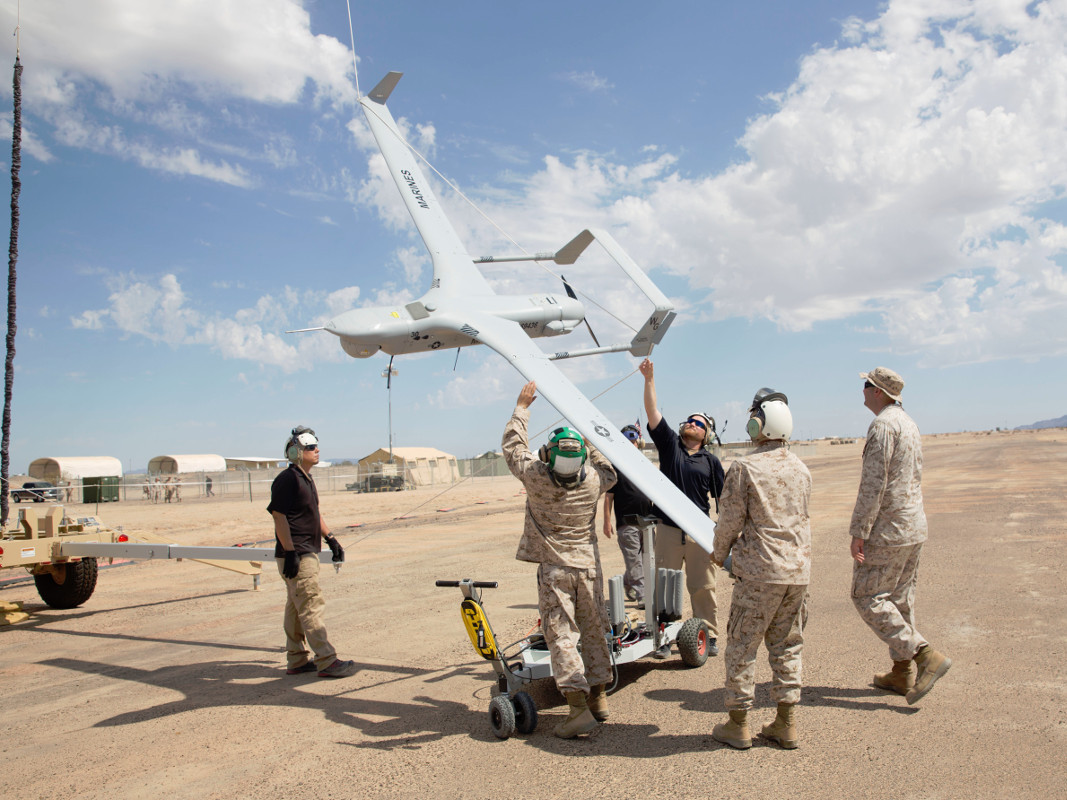
The recent first-of-its-kind expeditionary warfare exercise in Hawaii only underscores the drone’s still growing importance to the Marine Corps. The RQ-21 also made its debut in Australia this month, where the latest rotation of personnel assigned to Marine Rotational Force-Darwin (MRF-D) conducted a first flight in that country at the Bradshaw Field Training Area, Northern Territory, on Aug. 8, 2020.

The Marine Corps’ has an expanding interest in unmanned capabilities broadly, from hand-launched systems to support small unit operations to much higher-end, long-endurance systems with beyond-line-of-sight control systems that are larger and more capable than the RQ-21, as well. The service recently began operating a small number of MQ-9 Reapers, which it acquired as a stepping stone to developing its own large unmanned aircraft capability through the Marine Air-Ground Task Force Unmanned Aircraft System Expeditionary, or MUX, program. MUX, which initially envisioned a high-end, multipurpose system that could operate from amphibious ships, as well as land-based sites, has been significantly scaled back in the two years since its public announcement.
That’s not to say that the Marine Corps’ ambitions in this regard have diminished. The radical new Force Design 2030 concept, which Commandant General David Berger revealed in March, is already cutting very traditional capabilities, including all of the service’s tanks, in favor of an increased focus on unmanned systems and stand-off missiles. You can read more about this new force structure plan in this past War Zone piece.
“As a ‘stand-in’ force of the future, the Marine Corps requires a family of UAS [unmanned aerial system] capabilities. We need to transition from our current UAS platforms to capabilities that can operate from ship, from shore, and able to employ both collection and lethal payloads,” Berger wrote in a Force Design 2030 overview document. “These future capabilities must be expeditionary and fully compatible with Navy platforms and command and control networks.”
He also said that he felt that “short-range, low endurance unmanned aerial systems (UAS) incapable of employing lethal effects,” which could include the RQ-21, were an area where the Corps was “over-invested.” However, it seems likely that improved versions of the RQ-21, together with new and improved payload options, including the potential to employ small precision-guided munitions, will continue to be part of the Marine Corps unmanned ecosystem for the foreseeable future. It will be situated in an operational space between smaller drones that an individual might deploy and higher-end platforms that require more significant manpower, infrastructure, and other resources to operate.
All told, the RQ-21 looks set to become an ever-more useful tool in the Marine Corps armory and is now one that Marines can rapidly relocate to where they might need it using their MV-22 Ospreys.
Contact the authors: thomas@thedrive.com and joe@thedrive.com
